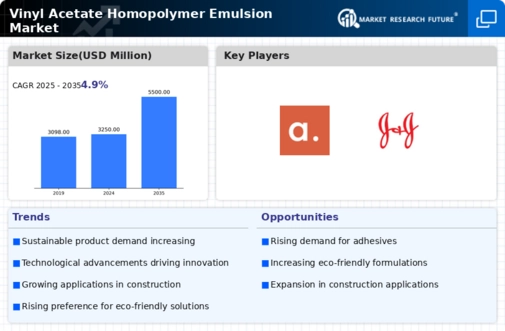Vinyl Acetate Homopolymer Emulsion Size
Vinyl Acetate Homopolymer Emulsion Market Growth Projections and Opportunities
Numerous variables define the Vinyl Acetate Homopolymer Emulsion market, driven by its widespread use in adhesives, coatings, and paints. Growing demand for eco-friendly and water-based alternatives drives this trend. Vinyl acetate homopolymer emulsions, which are versatile and stable, are employed as binders and coatings in many applications. These industries' growth and performance affect vinyl acetate homopolymer emulsion demand, making them vital manufacturing components.
The Vinyl Acetate Homopolymer Emulsion market is driven by regulations and environmental concerns. These water-based emulsions support worldwide VOC reduction and sustainability. Air quality and emission regulations affect vinyl acetate homopolymer emulsion uptake in different industries. To meet regulatory obligations and satisfy environmentally sensitive consumers, manufacturers must follow these guidelines.
Global economic conditions shape the Vinyl Acetate Homopolymer Emulsion market. Economic factors including construction, industrial manufacturing, and consumer expenditure affect emulsion product demand. During economic expansion, sustainability practices and water-based coatings become more popular, driving vinyl acetate homopolymer emulsion demand. Conversely, economic downturns may affect consumer priorities, hurting market dynamics.
Emulsion manufacturing technology drives market growth. Polymerization, stabilizer, and performance innovations can improve vinyl acetate homopolymer emulsion quality, durability, and adaptability. Technologically advanced companies may better meet industry needs and gain a competitive edge in the Vinyl Acetate Homopolymer Emulsion market by investing in research & development.
Raw material availability and cost are crucial in the Vinyl Acetate Homopolymer Emulsion market. These emulsions use vinyl acetate monomer, water, and stabilizers. Raw material price fluctuations affect production costs and market dynamics. A reliable and efficient supply chain is needed to supply end-users with vinyl acetate homopolymer emulsions without disruptions and preserve market stability.
Geopolitics and trade policies also influence the Vinyl Acetate Homopolymer Emulsion market. Tariffs, trade agreements, and geopolitical conflicts affect chemical supply and demand. Market players must adjust to these external influences to manage global trade dynamics.
Key companies, market share, and strategic efforts affect Vinyl Acetate Homopolymer Emulsion market dynamics. To gain market share, companies innovate, extend their product portfolios, and develop strategic collaborations. To achieve a competitive edge in the continually changing market for water-based emulsions such vinyl acetate homopolymers, mergers and acquisitions are widespread.






Leave a Comment